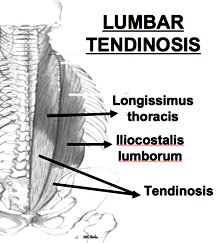MRI is currently the gold standard for identifying radicular pathology, but unfortunately, it requires preauthorization, which isn’t easy to obtain. Physical tests are what most practitioners depend on – despite the marginal reliability of the tests. The information in this article brings history and observation to the forefront of radicular diagnostics. Each factor listed can significantly increase the clinician’s ability to diagnose radiculopathies.
Lumbar Tendinosis
When one examines the anatomy of the erector spinae, particularly the longissimus thoracis and iliocostalis lumborum, it should be noted that the tissue extending from the thoracolumbar areas to the sacrum are tendinous/aponeurotic types of tissue. Aponeurosis refers to flattened tendons of any type, such as the pes anserinus tendon or the aponeurotic tendon of the gluteus minimus as it attaches to the greater trochanter.1 Some tendons even extend into muscles and are called intramuscular tendons. According to Benjamin and McGonagle, "Research shows that paraspinal muscle tendinosis and enthesopathy (entheses: where tendons and ligaments attach to bone) could be a common cause of low back pain."2

One of the chief characteristics of tendinopathy is the gradual onset of morning stiffness in the tendon.3 This morning stiffness is often found in Achilles tendinosis. Can this also be a reason for low-back morning stiffness? Tendinosis-type tissue often is nodular, which can be felt parallel to the lumbar spinouses or paraspinal areas. Clearly, much success with treating tendinosis has been achieved using mechanical-loading techniques on the paraspinal and sacral areas, such as Graston Technique, ART, friction massage, neuromuscular re-education and others. Langevin and Sherman wrote about increased connective-tissue stiffness due to fibrosis as an important link in the pathogenic mechanism leading to chronic pain.4 Changes in connective tissue surrounding the tendon and intratendinous degeneration in the body of tendons due to overuse, hyper- and hypomobility can result in either atrophy or fibrosis. Micro-injury can create inflammation, tissue hypo-oxygenation and cytokines such as TGF-1, causing fibrosis. I have several patients who see a massage therapist in Florida who literally brings them to tears working on their spinal musculature. He is extremely busy, but there is really no need to torture patients. There are excellent techniques mentioned above that are essentially painless.
However, treating tendinosis is not the end-all for chronic lumbar pain, just as treating the extensor carpi radialis brevis enthesis is not all that is necessary for a tennis elbow. There is that vast subject of rehabilitation covering whole-body and joint stability/mobility, abnormal motor patterns, endurance and strength, etc.
References
- Benjamin M, Kaiser E, Milz S. Structure-function relationships in tendons: a review.J Anat 2008;212:211-28.
- Benjamin M, McGonagle D. The anatomical basis for disease localization in seronegative spondyloarthropathy at enthuses and related sites. J Anat 2001;199:503-26.
- Khan KM, Cook JL, Bonar F, Harcourt PAM. Histopathology of common tendinopathies. Update and implications for clinical management. Sports Med 1999;27:393-408.
- Longevin HM, Sherman KH. Pathophysiological model for chronic low back pain integrating connective tissue and nervous system mechanisms. Med Hypoth 2007;68(1):74-84.


